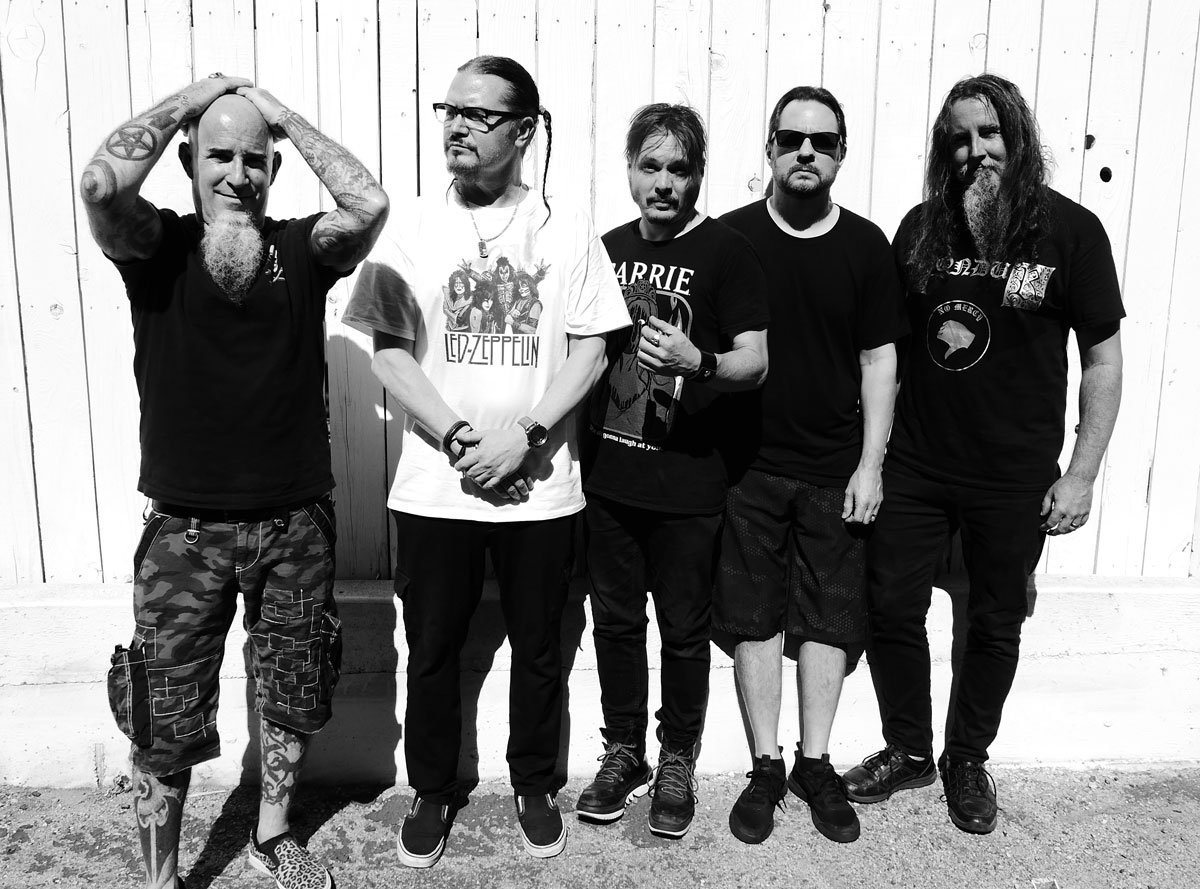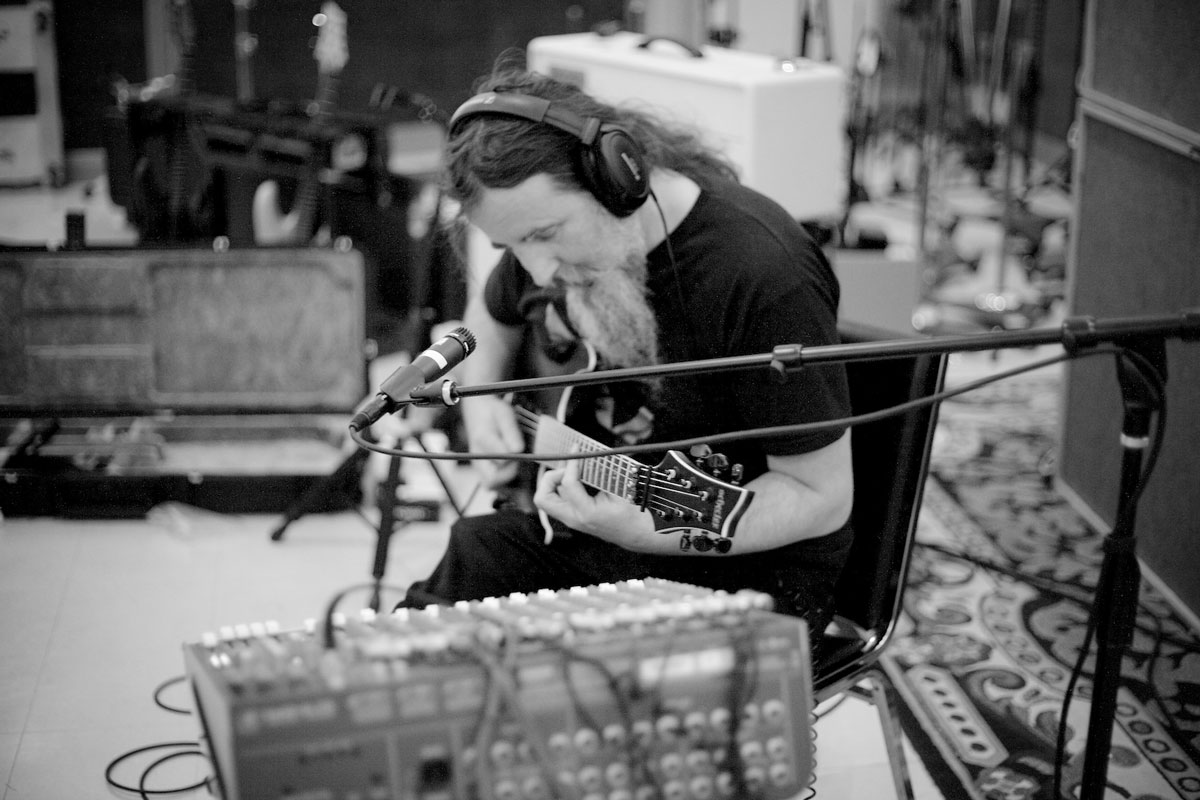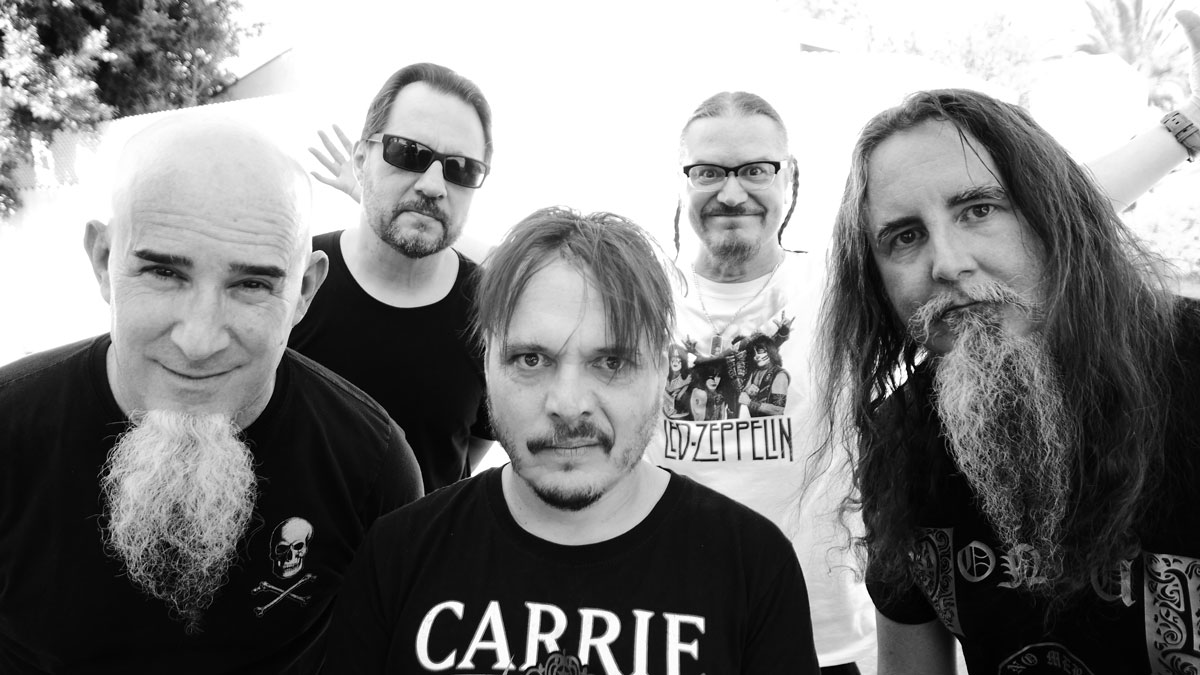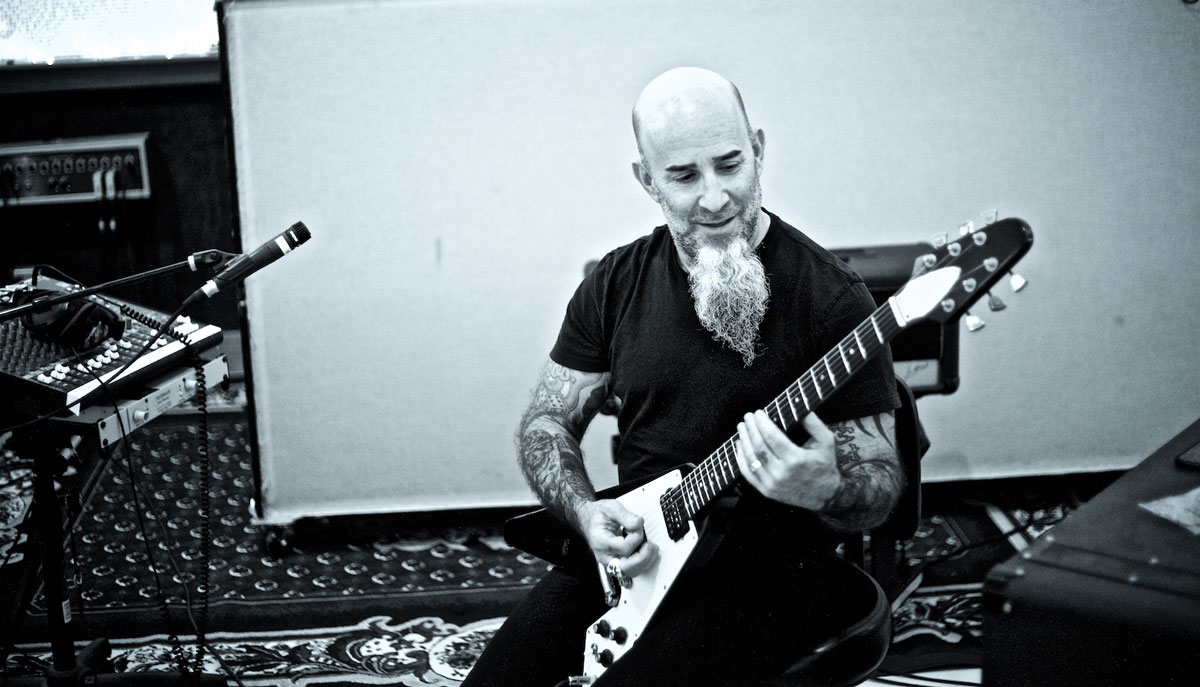Mr. Bungle's Trey Spruance and Scott Ian: “We’ve made the best thrash album of 1986 that nobody ever heard!“
How the genre-defying avant-garde metal veterans came to enlist Anthrax's thrash pioneer to re-record their debut album, The Raging Wrath of the Easter Bunny Demo, 34 years later
![[L-R] Scott Ian and Trey Spruance of Mr. Bungle](https://cdn.mos.cms.futurecdn.net/miKVLKPaTmRCwBE4Uj9sBF.jpg)
“The idea of Mr. Bungle coming back had been floating around for years but there was never a lightning strike to actually do it,” says founding guitarist Trey Spruance.
It’s a reunion few could have predicted, arriving some 20 years on from their last live appearance and 21 years after third full-length California. With thrash pioneers Dave Lombardo and Scott Ian joining ranks for new album The Raging Wrath of the Easter Bunny Demo – a re-recording of their 1986 self-released tape – it’s easily the heaviest the Mike Patton-fronted genre-smashers have ever sounded...
“This was a spontaneous idea that our bass player Trevor [Dunn] had,” continues Spruance. “I don’t know if it was on a Fantômas tour but he was sitting with Dave Lombardo. We weren’t really sufficiently motivated to do a reunion until now.
“The idea of going back to revisit our true roots – not 12 bar blues roots and Led Zeppelin riffs but death metal – felt interesting...
“It snowballed from there and felt like the cleverest way of doing a reunion. It wasn’t even a reunion to being with, we weren’t going to call it Mr. Bungle – it was going to be Raging Wrath Of The Easter Bunny and be a different thing. But then we realized no way, this is the core of the band and the heart and soul of Mr. Bungle…”
For Anthrax’s founding guitarist Scott Ian, getting the call to join one of his favorite bands was equally as surprising. Naturally, it was an instant no-brainer – though he’d be the first to admit he knew he had his work cut out for him…
“No offense to Trevor and his little four-track in 1986, but we were able to do this demo properly,” laughs the thrash pioneer. “My initial reaction when joining was the realization that this would be a Mount Everest-sized mountain of work to learn. I was familiar with the style of it all, that was very much in my wheelhouse.
Get The Pick Newsletter
All the latest guitar news, interviews, lessons, reviews, deals and more, direct to your inbox!
“It was the arrangements that were the hard parts, these seven-and-a-half minute tracks with over 90 changes. That’s something I was not used to at all and a big learning curve for me…
“There’s a lovely noisiness and fun to the original demo, that’s what made me like it in the first place but it’s not something I could turn on all the time and listen to.
“Whereas now we’ve made a record with brutal guitar tones and Dave Lombardo on drums, with Mike screaming his balls off. I’m not afraid to say we made the best thrash album of 1986 that nobody ever heard!”
Here the two guitarists at the helm of the assault on the new recordings talk us through the devastating tones and finger-twisting riffs…
Congratulations on completing what’s undoubtedly the most guitar-heavy Mr. Bungle release yet…
I love the fact they hardly did anything, they made three records within nine years and there’s been nothing for two decades. They’re like an enigma
Scott Ian
Trey: “It’s funny, if you think about all the other Mr. Bungle music from a guitar perspective, there’s not really one song where you can go, ‘Hey, play that riff!’ Sometimes people ask me to play one and none of them are really that interesting…
“They’re part of a larger whole but a bit weird on their own. You don’t recognize the song from the guitar parts. But this time, it’s a full-on guitar assault!”
Scott: “I just love the fact that when they decided to bring Mr. Bungle back, I was somehow on the list. They’ve been a constant in my life. Their music just moves me and feels completely original.
“They’ve never sounded like anything else going on at the time – you could call it thrash metal, death metal, funk or ska – but it’s everything. This band is truly genre-smashing. It felt like they were just showing off at points, being such insane musicians operating at levels other people couldn’t even as teenagers.
“I also love the fact they hardly did anything, they made three records within nine years and there’s been nothing for two decades. They’re like an enigma.”

What are your favorite guitar moments on the new album?
Trey: “I think the opening riff from Raping Your Mind that Trevor wrote is just a classic. It’s up there with Bonded By Blood and all the classic metal from that era… in my opinion.
“When I relearned Bungle Grind, which is one I wrote, it was a lot smarter than I remembered it to be. I always thought it was idiotic, weaving a bunch of disparate ideas together but no man. It was actually pretty well thought-out.
“Sudden Death has a couple of riffs that Patton wrote, every once in a while he’d write something that was so good you’d feel like you’d heard it before. There’s one punk riff that’s just so perfect, I absolutely love that one.”
Preparing for the live shows must have been intense, to say the least…
Scott: “It was going to be just a small club gig initially. We had plans to make the album and figured it would be worth playing a show to tighten our belts before hitting the studio. But then it turned into seven shows… three in LA, two in San Francisco and then two in New York. We could have carried on for months.
Having Scott there holding down the fort with the riffing, you just couldn’t have a more solid foundation
Trey Spruance
“We had one week of rehearsal but I had to work on the material for five months. Trevor and Trey made new demos to even be able to learn the stuff. I don’t really consider this a re-recording because it’s never been properly recorded until now.
“It’s weird that it was 34 years in between the demo and the album. That’s gotta be some kind of record… take that, Guns N’ Roses [laughs]!”
Trey: “It took me a while to figure that stuff out again, but the shows were pretty cathartic! Also having Scott there made it a whole new thing for us. Somehow in the rehearsals, from the very beginning with Scott and Dave, we locked into being a tight unit.
“It’s not like Mr. Bungle in the past, where there’s all this extreme detail going on with the arranging and you have to really figure out what the hell’s going on. Having Scott there holding down the fort with the riffing, you just couldn’t have a more solid foundation.
“We rehearsed for about five days before the first show and it just felt completely natural on stage. In my experience, it’s a little bit weird to be a band for five days and feel like you’ve been playing together for 100 years. It as nice to be up there and not sweating our balls off in fear...”
Judging from the footage we’ve seen, it was a resounding success!
Scott: “I remember telling everyone this was going to be big news. So one show at The Troubadour in LA turned into four at the Fonda Theatre, which was about three times bigger, and more in San Francisco and New York.
“By then, offers were coming in from around the world… and we hadn’t even stepped foot in the studio! I knew there was going to be big excitement about this. And the shows were insane.
“They sold out instantly and the audiences were amazing. We only played the Raging Wrath stuff and filled out the set with cover songs of stuff we were all listening to between 1982 and 1986.
“It was all thrash or hardcore or crossover. Anything from SOD [Stormtroopers of Death] to Slayer – we did Hell Awaits – to Crumbsuckers, Cro-Mags, Circle Jerks, a band called Siege which we all loved, The Exploited and Corrosion Of Conformity.
“The audiences were thrilled to be part of it because nobody had seen Mr. Bungle in about 20 years.”
In the footage it looks like you are both playing through 5150s, with Schecter and Jackson guitars on each side of the stage…
I had to go out and buy a good guitar because I’ve never really had a decent one! Any picture you see of me, I’ll be playing a piece of shit
Trey Spruance
Trey: “Yeah, one of the 5150s was for backup. I use the old '90s ones so it’s good to have another there in case my main one craps out. I’m terrible with names, but I think the Schecter was the SLS, it’s the one with the Sustainiac pickup.
“I have not been focused on guitar gear, pretty much since our first demo. I don’t think about equipment at all. But for doing this, I had to dig back in and figure out what the hell was going on in the guitar world.
“I had to go out and buy a good guitar because I’ve never really had a decent one! My first guitar was actually good, a G&L F-100, and then it was all downhill from there. Just complete crap and junk. Any picture you see of me, I’ll be playing a piece of shit.
“The guitar is a means to an end for me, more of a compositional tool in a way. So this time I had to shred and respect this fucking genre with a real guitar so I got a Schecter. It opened up a whole new world for me. I didn’t even know I could play like that.
“Suddenly I could do all this shit I could do as a kid, plus all these other atonal doors that I never would have dared to. Now with the Sustainiac I can do all the shit that happens by chance and if you’re lucky even control some of it! It’s a fucking amazing guitar.”

And what about your rig, Scott?
Scott: “I was also using my EVH 5150 for the shows. It’s the newer one with EL34s, so two half stacks plus my Jackson King Vs. I can’t remember if I had the slime one with me, but certainly the black one with the Floyd, one of the white ones and my Korina one with gold hardware.
“I wasn’t really running much in terms of pedals, it was mainly rhythm tones from the amp. I did use one of those Gamechanger Audio Plasma [distortion] pedals for crazy noises throughout the show, plus my EVH Phase 90 and maybe some delay for the clean tones on Summer Breeze by Seals And Crofts.
“I think it was the MXR Carbon Copy, just for a bit of slap on the chords. That was it, effects-wise.”
Was it the same kind of set-up for the recordings?
Scott: “On the record, I used all of that plus some pedals that Mike and our engineer had, mainly for weird noises. I had the Slash MXR Octave pedal, Fortin’s Zuul noise gate and Spliff splitter going into the effects loop to keep it dead silent.”
I wasn’t really running much in terms of pedals, it was mainly rhythm tones from the amp
Scott Ian
Trey: “For most of the record, my tone is coming from this big thick amp simulator – the Amptweaker Tight Metal Pro pedal. I know how temperamental 5150s are and we were renting equipment everywhere we went. I just wanted a reliable and consistent tone wherever we are.
“If I have time to dial the 5150 exactly right, then sure I would bypass that thing. When I use the 5150 on its own, I have to figure out the gating and it will work different from amp to amp.
“Then I discovered the Amptweaker has a second gain stage and its own effects loop, plus a really fucking tight gate. There’s a lot you can do with one kick of the pedal and you need that with how fast this stuff is going by. You need a streamlined one-stop shop! It has a fucking brutal tone.
The guy from Pig Destroyer uses it and he has a kickass sound. I thought I would do that instead of trying to copy Scott’s sound, I wanted to bring in a different kind of balls to the show.
“Then I went to the Schecter factory after we’d done the gigs, they gave me a couple of Foxgear pedals which I used on the record. One I got a lot of use out of was the Anubi. That was responsible for all the long sustains and cascading walls of sound.
“I used the Foxgear stuff for the tight delays, the quick analog kinda tones you hear on a lot of those '80s thrash lead sounds. You need a short slapback before you do anything else, to help make it all chaotic sounding.”
What was your approach for the solos, Trey? Did you freestyle it or map everything out using theory?
Trey: “I should say I went, ‘Fuck it, let’s play any note and see what happens!’ but no. I’m a complete theory nerd. My whole career is made out of music theory stuff. My solos are blocked as you describe, I know which scale I’m using over each block in the solo – so it’s Phrygian here, then Whole Tone, then maybe Diminished.
“There’s a Coltrane kind of thing going on there. There’s the Slonimsky method, he created an encyclopedia of scales that can be compressed smaller than an octave or go beyond an octave.
“They’re repetitive and more like geometric patterns irrespective to the key you are in. They register to the ear as making harmonic sense but they lose connection with key centers as we normally recognize them. You pull that out, then go back to the Phrygian run. It’s fun to jumble it all out and throw that at people.”
Outside of Mr. Bungle, you’ve been very active in soundtracks and scoring. What have you learned from all those musical experiences?
Everybody gets frustrated with the limitations of their instrument. Maybe focus on what frustrates you about the guitar, the things you can’t do and what you’d like to do beyond that
Trey Spruance
Trey: “Everybody gets frustrated with the limitations of their instrument. Maybe focus on what frustrates you about the guitar, the things you can’t do and what you’d like to do beyond that.
“For me it was learning to play other related stringed instruments that were like guitars, so still familiar enough. I kept taking it further and further, and eventually got comfortable working within a bigger range of sonorities.
“Then when you go back to the guitar, you start taking those things with you just by instinct… I feel like it’s a feedback loop. The more you expanded your horizons outside of guitar, the more that exploration will inform your playing - just by natural osmosis.
“That will keep growing until all of a sudden you feel comfortable writing for violins, violas and cellos! The whole string section starts to become more accessible. After the pain of unlocking all the limitations, you start relating to other players because you’ve been through similar things on your own instrument.
“Honestly, once you’ve expanded through enough instruments like that, you can pretty much write for anything. All you need to do is go beyond your limitations.”

Scott, we loved how Mike praises your “bionic right arm” in the press release. No one’s going to be arguing with that description…
Scott: “Anyone that’s great at what they do has basically put the time in. It came from sitting in front of the television with a metronome for months and months to nail just one particular riff or rhythm. That’s all I did as a kid! Tightness and speed can only come out of practice.
“I actually didn’t know how to do it until I was in Anthrax… We discovered who we were together. I was not able to play a song like Deathrider on Fistful Of Metal back in the '70s because no one was doing that… it didn’t exist yet!
“I had to learn how to play guitar to be in my band, essentially. We heard the ideas in our heads and then had to learn how to play them. Then I got better and better.
“I’m good at a lot of styles, but I’m really good at being the rhythm guitar guy in Anthrax. It wouldn’t work in AC/DC. Malcolm’s style is totally different. Same with Tony Iommi or Rudolf Schenker or Johnny Ramone. I can copy those dudes but I will never be those dudes! I guess it’s a bit closer with what James Hetfield or Kerry King and Gary Holt do – there’s a closer relationship to my band and their bands.
“I can ape a Metallica song a lot easier than a Red Hot Chili Peppers song! It comes down to what makes you happy and whatever is in your heart. You just have to play the shit out of it.”
And how about your warm-ups, Trey? Tracks like Raping Your Mind and Glutton For Punishment certainly look demanding on both hands…
That’s the best warm-up routine there is. To do those rhythms at that speed for a whole set… don’t think sitting in your bedroom and learning the riffs will get you there
Trey Spruance
Trey: “I’ll start slow and run all the modes in one key up and down the neck a few times. I really concentrate on picking every note correctly instead of using hammer-ons and pull-offs, because that’s my weakness! I have to work on being fluid.
“Sometimes it’s about where the pick hits the string, it might be diagonal or straight across… I would speed up and slow down until I felt good at both and then start wailing. That’s my routine.
“I can play the riffs for 40 seconds or so - and I’m great for those 40 seconds - but playing a five minute song with no breaks and going straight into the next song is something that took months of practice.
I had to stand up and go through the set with only 10-second breaks in between songs to be able to do the set. That’s the best warm-up routine there is. To do those rhythms at that speed for a whole set… don’t think sitting in your bedroom and learning the riffs will get you there.
“When I saw Scott Ian come in, he was like, ‘No problem, I can do this!’ and that only comes from years and years of fucking standing there going ‘Drrrrrrrrrrr!’”

Finally, if someone wanted to really hone in on your style of playing, what would you tell them?
Trey: “I would definitely recommend the Slonimsky Thesaurus of Scales [and Melodic Patterns]. That book will completely change how you think about harmonics. I know for certain Coltrane was getting that stuff under his fingers in between sets, trying out different things.
“It unlocks new ways of thinking about it – you don’t need to be staring at the book after a while, once you understand the principles behind it. Obviously it’s not the technical stuff like how to hold the pick and getting your hands synchronized.
People hate to practice – they want to know if there’s a secret or magic way. There is no magic way
Scott Ian
“I was devastated to learn how shitty the correspondence between my left and right hands were when we started this process. For the first time since I was 15 years old, I sat and practiced the guitar to synchronize them.
“My left hand is fast and my right hand is fast, but they don’t talk at the same time. I had to watch YouTube videos to figure out ways to improve that - and it’s a really good resource for all that technical shit.
“It’s the physical stuff on how to pick, how to get your pinky and ring finger to loosen up… I hadn’t really looked at that stuff before!”
Scott: “People hate to practice – they want to know if there’s a secret or magic way. There is no magic way. When I warmed up for the shows, I knew I was ready when I hit 214bpm. If I can downpick and alternate pick at that speed, I’m ready for the show… and that’s fuckin’ fast!
“It’s intensified as I’ve gotten older. I need to warm up even more nowadays. Hey, even a bionic arm’s parts get old. You need to get the oil can out like the Tin Man from Wizard Of Oz and loosen up [laughs]!”
Amit has been writing for titles like Total Guitar, MusicRadar and Guitar World for over a decade and counts Richie Kotzen, Guthrie Govan and Jeff Beck among his primary influences as a guitar player. He's worked for magazines like Kerrang!, Metal Hammer, Classic Rock, Prog, Record Collector, Planet Rock, Rhythm and Bass Player, as well as newspapers like Metro and The Independent, interviewing everyone from Ozzy Osbourne and Lemmy to Slash and Jimmy Page, and once even traded solos with a member of Slayer on a track released internationally. As a session guitarist, he's played alongside members of Judas Priest and Uriah Heep in London ensemble Metalworks, as well as handled lead guitars for legends like Glen Matlock (Sex Pistols, The Faces) and Stu Hamm (Steve Vai, Joe Satriani, G3).











